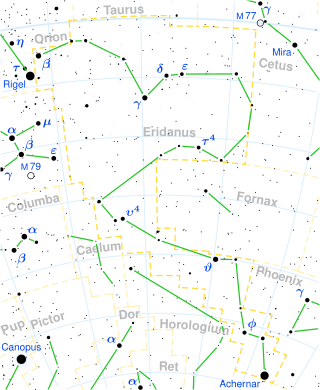Top Qs
Timeline
Chat
Perspective
Delta Eridani
Star in the constellation Eridanus From Wikipedia, the free encyclopedia
Remove ads
Delta Eridani, Latinized from δ Eridani, also named Rana, is the fifth-brightest star in the constellation of Eridanus.
The star is visible to the naked eye with an apparent magnitude of 3.54. It is relatively near to the Sun, with a distance of about 29.6 light-years as determined from parallax.[1] The star is drifting closer with a radial velocity of −6 km/s.[5]
Remove ads
Nomenclature
Delta Eridani is sometimes called Rana;[11] Rana means frog in Latin. This name first appeared as Rana Secunda, the "second frog", in Giuseppe Piazzi's star catalogue; this was likely a misattributed name for Beta Ceti (Diphda), known as the "second frog" in Arabic.[12] The name Rana was approved by the IAU Working Group on Star Names on 4 April 2022.[13]
In Chinese, 天苑 (Tiān Yuàn), meaning Celestial Meadows, refers to an asterism consisting of δ Eridani, γ Eridani, π Eridani, ε Eridani, ζ Eridani, η Eridani, π Ceti, τ1 Eridani, τ2 Eridani, τ3 Eridani, τ4 Eridani, τ5 Eridani, τ6 Eridani, τ7 Eridani, τ8 Eridani and τ9 Eridani.[14] Consequently, the Chinese name for δ Eridani itself is 天苑三 (Tiān Yuàn sān, English: the Third Star of Celestial Meadows.)[15]
Remove ads
Characteristics
The stellar classification of this star is K0 IV,[3] matching a subgiant star that has exhausted its core hydrogen. This has caused the star to expand and become cooler than a comparable main sequence star. Stellar modelling indicates it is near the end of the subgiant stage and about to transition into a giant. It is an estimated six billion years old[8] with 33% more mass than the Sun.[9] The star has 2.35 times the size of the Sun and is radiating three times the Sun's luminosity from its photosphere at an effective temperature of 5,022 K.[7]
Delta Eridani was catalogued as a suspected RS Canum Venaticorum variable in 1983,[16] varying slightly in brightness between magnitudes 3.51 and 3.56,[17] although subsequent observations did not bear this out[18] and an examination of the star using interferometry did not detect the presence of a companion at the expected distance.[8] Thus, this classification is now considered erroneous.[19] The star has a very low level of chromospheric activity.[19] A low projected rotational velocity of under 1 km/s and the lack of radial velocity variation suggest that this star is being viewed from nearly pole-on.[8]
Remove ads
See also
References
External links
Wikiwand - on
Seamless Wikipedia browsing. On steroids.
Remove ads

